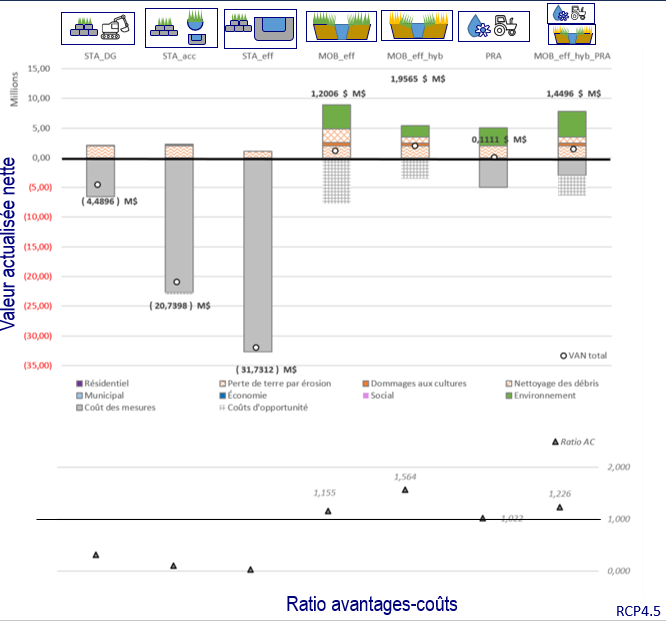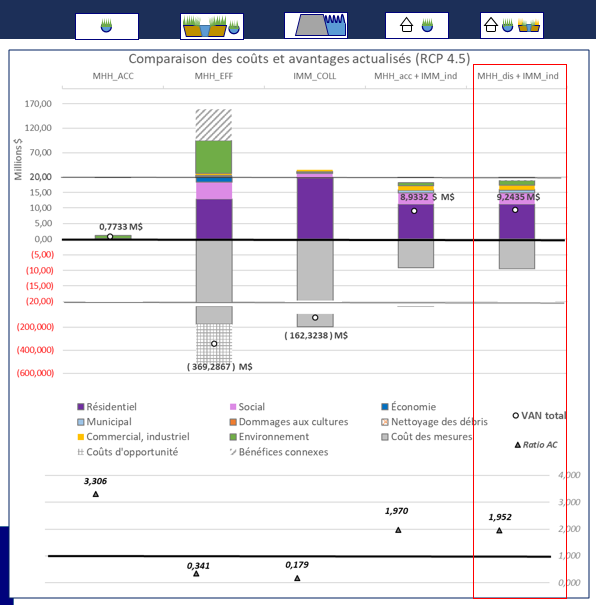Cost-benefit analysis of adaptation to riverine flooding
The preliminary results of the CBA have supported the adoption of wetlands and water bodies conservation objectives in the COBARIC water master plan update and the development of the Chaudière-Appalaches regional wetlands and water bodies plan (PRMHH).
Project details
Principal(s) investigator(s)
Context
In Canada, flooding is the most common natural hazard and causes the most property damage. In recent years, the Richelieu River flood of 2011, the Calgary flood of 2013 and the spring floods of 2017 that affected a large portion of southern Québec all generated major economic, environmental and social impacts.
In each of these cases, the floods called into question the practice of building in flood zones and land-use planning methods. They also highlighted the vulnerability of many communities and the need to make decisions that will reduce risk and encourage adaptation to climate change, which is likely to affect the intensity and frequency of flooding.
To this end, cost-benefit analysis is a decision support tool that integrates the multiple dimensions and issues relating to flood risk in order to prioritize adaptation measures that are the most cost-effective for society
Objective(s)
Quantify the costs and benefits of different adaptation solutions aimed at reducing and managing flood risk at different spatial scales.
Methodology
-
Mobilize key adaptation stakeholders in each target community;
-
Identify adaptation measures for reducing flood risk and increasing community resilience through a participatory approach integrating participatory mapping and a citizens’ jury;
-
Perform hydrological and hydraulic modelling under a future climate, with and without adaptation;
-
Carry out a cost-benefit analysis by
-
estimating the impacts of non-intervention,
-
estimating the costs of adaptation measures and
-
identifying and quantifying the economic, social and environmental impacts of the selected adaptation measures;
-
-
Disseminate the results to the communities affected by riverine flooding (case studies and others) with the aim of integrating the conclusions into regional planning tools.
Results
Coaticook River at Compton Case Study
The risk analysis shows a total value of land and buildings exposed to river hazards of $12.2 M, including 18 residential buildings potentially exposed to at least one river hazard. The results of the CBA (Figure 1) clearly indicate that for society, the most economically beneficial scenario over the next 50 years is the river mobility approach with a narrow multihazard corridor and adaptation of uses in lower-risk sectors. This is a “no regrets” option, i.e., cost effective in the face of the uncertainty of climate risk.

Figure 1: 50-year cost-benefit balance for the different adaptation scenarios, compared with the reference scenario, for the Coaticook River at Compton case study (RCP 4.5). STA-DG: stabilization with dredging, STA-acc: acceptable stabilization, MOB-eff: effective mobility, MOB-hyb: hybrid mobility, PRA: adaptation of agricultural practices, MOB-hyb+PRA: hybrid mobility and adaptation of agricultural practices.
Chaudière River Watershed Case Study
Despite the relocations already carried out, the risk analysis shows a total value of land and buildings exposed to open water flooding of $273,805 M. This represents more than 2,000 potential flood victims. The results of the CBA (Figure 2) clearly indicate that the two most economically beneficial scenarios for all of society over the next 50 years balance human and natural uses through relocation and immunization measures for residential and commercial buildings, combined with the restoration of wetlands and water bodies.
In particular, the option of strategically distributing wetlands and water bodies across the territory to increase riparian habitat connectivity is more robust in the face of residual risk.

Figure 2: 50-year cost-benefit balance for the different adaptation scenarios, compared with the reference scenario, for the Chaudière River Watershed case study (RCP 4.5). MHH-ACC: acceptable wetlands and water bodies, MHH-EFF: effective wetlands and water bodies, IMM_COLL: collective immunization (diking), MHH_acc + IMM_ind: acceptable wetlands and water bodies and individual immunization, MHH_dis + IMM_ind: distributed wetlands and water bodies and individual immunization.
In both case studies, reducing vulnerability (uses) was more cost-effective than reducing the hazard (control of water levels). The most cost-effective solutions presented a balance between efficacity, the cost of the measures, and ecosystem benefits. The implementation of adaptation measures raises societal issues related to the distribution of impacts among actors, the feasibility of implementing natural infrastructure as an adaptation solution, and the loss of agricultural land in high-probability multihazard sectors. This calls for regulatory consistency.
This study reveals adaptation opportunities related to the use of the wetlands and water bodies compensation bank to reduce river-related damages and the diversification of the regional economy through green infrastructure.
Retombées pour l'adaptation
The preliminary results of the CBA have supported the adoption of wetlands and water bodies conservation objectives in the COBARIC water master plan update and the development of the Chaudière-Appalaches regional wetlands and water bodies plan (PRMHH).
Training on the method used was offered to the members of the Regroupement des organismes de bassins versants to transfer the knowledge and skills.
The results, methods and expertise are currently being put to use in regulatory transformation related to flood risk management and the establishment of flood project offices.
The methodological guide will equip communities
exposed to river hazards to produce cost-benefit
analyses of adaptation options in the context of climate change.
Scientific publications
Funding



Other participants
-
Local municipalities and MRCs
-
ROBVQ
-
COBARIC
-
COGESAF
-
Université de Sherbrooke
-
Université du Québec à Montréal